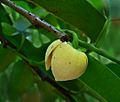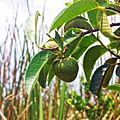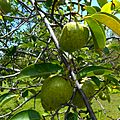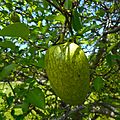Pond apple facts for kids
Quick facts for kids Pond apple |
|
|---|---|
 |
|
| Fruit | |
| Conservation status | |
| Scientific classification | |
| Genus: |
Annona
|
| Species: |
glabra
|
The pond apple (scientific name: Annona glabra) is a cool fruit tree that grows in warm, tropical places. It's part of the same plant family as the soursop and cherimoya. People also call it the alligator apple because American alligators love to eat its fruit! Other names include swamp apple, corkwood, bobwood, and monkey apple.
This tree comes from places like Florida in the United States, the Caribbean islands, Central and South America, and West Africa. You can find it a lot in the Everglades. The pond apple tree loves wet places like swamps and can even handle salty water. It cannot grow in dry soil. However, in some places like Sri Lanka and Australia, the pond apple is considered an invasive species. This means it grows too much and can harm the local plants.
Contents
What Does the Pond Apple Look Like?
Pond apple trees can grow quite tall, up to 12 meters (about 40 feet) high. They have thin, gray trunks and sometimes grow in groups.
Leaves and Flowers
The leaves are shaped like an oval with a pointed tip. They are about 8–15 cm (3–6 inches) long and 4–6 cm (1.5–2.5 inches) wide. The top of the leaves is light to dark green. Pond apple leaves have a special smell, a bit like green apples, which helps tell them apart from other plants like mangroves.
The flowers of the pond apple are small, about 2–3 cm (1 inch) wide. They don't last very long. Each flower has three outer petals and three inner petals. The petals are pale yellow or cream, but the center of the flower is a bright red.
Fruit and Seeds
The fruit is shaped like an apple, either round or a bit longer. It's about 7–15 cm (3–6 inches) long and up to 9 cm (3.5 inches) wide. The fruit falls from the tree when it's green or turning yellowish. Inside, the fruit has 100 or more light yellow-brown seeds, each about 1 cm (0.4 inches) long.
Where Pond Apples Grow
Pond apples grow best in very wet places. Their seeds and fruit can spread easily during rainy seasons. When they fall into swamps and rivers, they float to new areas, even coastlines.
Studies have shown that pond apple seeds can float in both salty and fresh water for up to a year! About 38% of these floating seeds can still grow into new plants when they land in soil. Even though the trees can handle a lot of water, their roots don't like being constantly flooded. Pond apple trees are more resistant to flooding than other trees in the same family.
Uses of the Pond Apple
The fruit of the pond apple is different from other fruits in its family. When it's ripe, the inside is yellow or orange, not whitish.
Eating the Fruit
Humans can eat the fruit, and it tastes a bit like a ripe honeydew melon. You can make it into jam. It's also a popular ingredient in fresh fruit drinks in the Maldives. Long ago, people would crush the seeds, cook them in coconut oil, and put them on their hair to get rid of lice.
The fruit smells sweet and tastes good, but it's not as popular as soursop or other similar fruits. Scientists have tried to use pond apple trees as a base for growing other fruits like sugar-apple or soursop. While this sometimes works at first, many of these attempts don't last.
Medicinal Uses
New research suggests that a special extract from pond apple seeds might have compounds that fight cancer. Scientists are studying this for possible medical uses.
Pond Apple as an Invasive Species
The pond apple is a big problem as an invasive species in northern Queensland, Australia, and in Sri Lanka. It grows in river mouths and blocks up mangrove swamps.
How It Spreads
The pond apple tree was brought to North Queensland around 1912. It was used as a base for growing other similar fruit trees. However, pond apple seedlings now cover riverbanks. They stop other native plants from growing. They also spread onto farms, growing along fences and drains. This plant can even take over natural areas, like what happened in Australia’s Eubenangee Swamp National Park.
In Australia, a bird called the southern cassowary helps spread pond apple seeds. Seeds have been found in cassowary droppings, traveling over 5 kilometers (3 miles) in one study. The southern cassowary itself is an endangered species in Australia. Part of the government's plan to help cassowaries is to plant trees they eat. Since pond apples are one of their foods, it's important to make sure cassowaries have other food options available. When pond apple populations are controlled, native plants can grow back on their own.
Government Classification
Because of its harmful effects on the environment, the Australian government calls the pond apple a "Weed of National Significance" (WONS). In Sri Lanka, it was brought in to help grow custard apples and then spread into wetlands around the city of Colombo.
Controlling Pond Apple Growth
Australia's Control Plan
The Australian government sees the pond apple as a harmful weed. Their Department of the Environment and Energy created a plan in 2001 to get rid of it within 20 years. This plan helps landowners figure out how to control pond apple outbreaks. It also helps them reduce financial damage. To stop people from growing and spreading pond apples, selling or bringing them into most parts of Australia is banned.
Ways to control pond apples include using fire, chemicals, or machines. Sometimes, a mix of these methods works best. The best time to control them in Australia is during the dry season, from August to November. So far, there haven't been studies on using natural biological controls for pond apples in Australia. Without these studies, trying to use biological methods could accidentally harm native Australian apple species that are in the same plant family.
Images for kids
See also
 In Spanish: Bagá de Cuba para niños
In Spanish: Bagá de Cuba para niños









